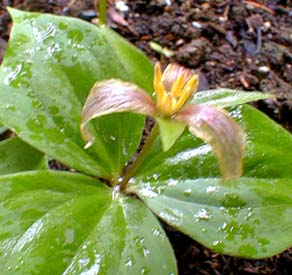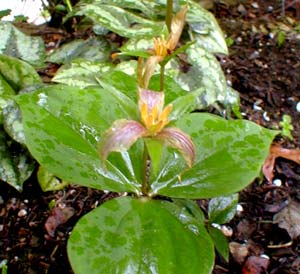
Trillium of the Ainu; or,
Small's Trillium
"If I knew
Only the herbs & simples of the wood,
Rue, cinquefoil, gill, vervain, & pimpernel,
Blue-vetch, & trillium, hawkweed, sassafras,
Milkweeds, & murky brakes, quaint pipes & sundew,
And rare & virtuous roots, which in these woods
Draw untold juices from the common earth,
Untold, unknown, & I could surely spell
Their fragrance, & their chemistry apply
By sweet affinities to human flesh."
-Ralph Waldo Emerson
(1803-1882)
(1803-1882)
This trillium has been identified as T. smallii. It's not exactly as the details for an ideal specimen of this species should be, but it is within the variability seen for a trillium with a distribution separated from island to island.
It was purchased when still a tiny young specimen mislabeled as T. chloropetalum & by the time it was mature enough to bloom, & for me to realize it couldn't possibly be the plant I thought I had obtained, a year or so had passed. I pointed out the mistake to the grower merely because I wanted to know what it actually was, not to be complaining, but those good people at Heronswood gave me a young T. chloropetalum anyway to make up for the mislabeling. Then from photographs I took of the wrongly labeled one, they decided the closest candidate among species they had offered in the last couple of years was T. smallii.
The Japanese name for this trillium is Enreisou (En-Ray-So-U), the Ainu's Flower, because it grows on Hokkaido, where the aboriginal Ainu dwell. It also grows on Honshu, Kyushu & Shikoku, hence the considerable variation in appearance for isolated populations. It is seen in moist wooded foothills & on mountainsides & sometimes in grassy harsher areas nearer to the sea.
 It is usually a small purple flower including purple anthers, but ours produces flowers of maroon-hued green petals, green bracts, & almost showy bright yellow anthers rather than the usual purple anthers.
It is usually a small purple flower including purple anthers, but ours produces flowers of maroon-hued green petals, green bracts, & almost showy bright yellow anthers rather than the usual purple anthers.These are fairly small flowers on quite a short stem (but not stemless or sessile), upright or barely nodding, over a comparatively large trio of leaves. Its small fruit look like ornately carved rocket-nose capsules. These were eaten by Ainu people, who additionally used the roots medicinally.
Though it's a small trillium, that's obviously not the reason it's called Small's Trillium. It is one of a great many plants named in honor of the American botanist, Dr. John Kunkel Small (1869-1938), first curator of the New York Botanical Garden, & best known for his work on plants of Florida, Louisiana & Texas. He wandered all over the deep south & southwest in what native peoples called his "weed wagon" collected specimens either for the botanical garden or to preserve in the herbarium.
The Trillium of the Ainu is humbler than most trilliums. An ideal specimen is quite a pretty little thing, but Maryland gardener Jim McKenney said on a gardening bulletin board that it can also be "about the homeliest Trillium I've ever seen." That may be an exaggeration, but when the blooms are green rather than purple, & given the briefer-than-average presence of the blooms, this shade perennial becomes pleasing primarily for blooming earlier than most of the trilliums (the photos here are from April), for its hardiness, for for its large leaves, & with any luck for its seed-capsules.
It can bloom as early as its second year when grown from seed, so develops way faster than most trilliums. As it ages into a clump producing more leaf-sets each year, it will eventually become impressive in its own humble manner.